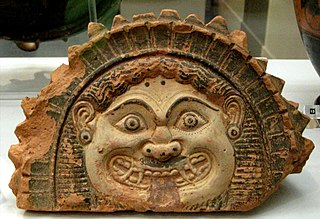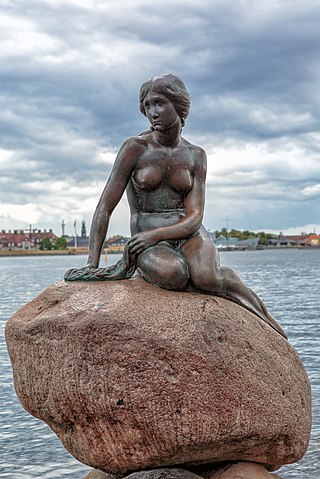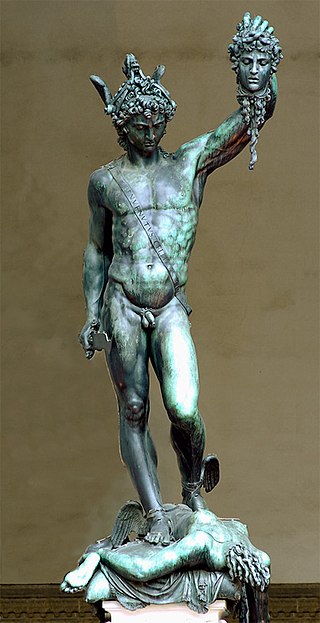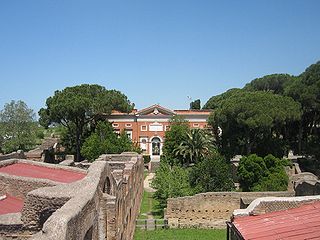Related Research Articles

Antonio Canova was an Italian Neoclassical sculptor, famous for his marble sculptures. Often regarded as the greatest of the Neoclassical artists, his sculpture was inspired by the Baroque and the classical revival, and has been characterised as having avoided the melodramatics of the former, and the cold artificiality of the latter.

Minerva is the Roman goddess of wisdom, justice, law, victory, and the sponsor of arts, trade, and strategy. She is also a goddess of warfare, though with a focus on strategic warfare, rather than the violence of gods such as Mars. Beginning in the second century BC, the Romans equated her with the Greek goddess Athena. Minerva is one of the three Roman deities in the Capitoline Triad, along with Jupiter and Juno.

Benvenuto Cellini was an Italian goldsmith, sculptor, and author. His best-known extant works include the Cellini Salt Cellar, the sculpture of Perseus with the Head of Medusa, and his autobiography, which has been described as "one of the most important documents of the 16th century".

Collect Pond, or Fresh Water Pond, was a body of fresh water in what is now Chinatown in Lower Manhattan, New York City. For the first two centuries of European settlement in Manhattan, it was the main New York City water supply system for the growing city. A jail was later built on the former pond. In the 20th century, the site became Collect Pond Park, which includes a reflecting pool to acknowledge the historic importance of this body of water.

Benvenuto Cellini is an opera semiseria in four tableaux by Hector Berlioz, his first full-length work for the stage. Premiered at the Académie Royale de Musique on 10 September 1838, it is a setting of a libretto by Léon de Wailly and Henri Auguste Barbier, who invented most of the plot inspired by the memoirs of the Florentine sculptor Benvenuto Cellini. The opera is technically challenging and was until the 21st century rarely performed. But its overture sometimes features in orchestral concerts, as does the concert overture Le carnaval romain which Berlioz composed from material in the opera.

In Greek mythology, Medusa, also called Gorgo or the Gorgon, was one of the three Gorgons. Medusa is generally described as a woman with living snakes in place of hair; her appearance was so hideous that anyone who looked upon her was turned to stone. Medusa and her Gorgon sisters Euryale and Stheno were usually described as daughters of Phorcys and Ceto; of the three, only Medusa was mortal.

Clash of the Titans is a 1981 epic fantasy adventure film directed by Desmond Davis and written by Beverley Cross, loosely based on the Greek myth of Perseus. Starring Harry Hamlin, Judi Bowker, Burgess Meredith, Maggie Smith and Laurence Olivier, the film features the final work of stop-motion visual effects artist Ray Harryhausen.

Piazza della Signoria is a w-shaped square in front of the Palazzo Vecchio in Florence, Italy. It was named after the Palazzo della Signoria, also called Palazzo Vecchio. It is the main point of the origin and history of the Florentine Republic and still maintains its reputation as the political focus of the city. It is the meeting place of Florentines as well as the numerous tourists, located near Palazzo Vecchio and Piazza del Duomo, and gateway to the Uffizi Gallery.

The Loggia dei Lanzi, also called the Loggia della Signoria, is a building on a corner of the Piazza della Signoria in Florence, Italy, adjoining the Uffizi Gallery. It consists of wide arches open to the street. The arches rest on clustered pilasters with Corinthian capitals. The wide arches appealed so much to the Florentines that Michelangelo proposed that they should be continued all around the Piazza della Signoria.
Cellini is a 2001 play by American playwright John Patrick Shanley. It is based on the process that the sculptor Benvenuto Cellini went through in order to create his mid-16th century work Perseus with the Head of Medusa.

The harpē (ἅρπη) is a type of sword- or sickle-like weapon mentioned in Greek and Roman sources, and almost always in mythological contexts.

Willem Danielsz. van Tetrode, known in Italy as Guglielmo Fiammingo, was a sixteenth-century sculptor of Dutch origin who served as a pupil of Benvenuto Cellini in Florence. On his return to Delft in the Netherlands in 1567–68, it has been suggested that he may have trained the young Adriaen de Vries and encouraged him to go to Florence.

Medusa and the other Gorgon sisters, Stheno and Euryale, have been featured in art and culture spanning from the days of ancient Greece to present day. Medusa is the most well-known of the three mythological monsters, having been variously portrayed as a monster, a protective symbol, a rallying symbol for liberty, and a sympathetic victim of rape and/or a curse.

The Little Mermaid is a bronze statue by Edvard Eriksen, depicting a mermaid becoming human. The sculpture is displayed on a rock by the waterside at the Langelinie promenade in Copenhagen, Denmark. It is 1.25 metres (4.1 ft) tall and weighs 175 kilograms (385 lb).

Perseus with the Head of Medusa is a bronze sculpture made by Benvenuto Cellini in the period 1545–1554. The sculpture stands on a square base which has bronze relief panels depicting the story of Perseus and Andromeda, similar to a predella on an altarpiece. It is located in the Loggia dei Lanzi in the Piazza della Signoria in Florence, Italy. The second Florentine duke, Cosimo I de' Medici, commissioned the work with specific political connections to the other sculptural works in the piazza. When the piece was revealed to the public on 27 April 1554, Michelangelo's David, Bandinelli's Hercules and Cacus, and Donatello's Judith and Holofernes were already installed in the piazza.

Medusa is a marble sculpture of the eponymous character from the classical myth. It was executed by the Italian sculptor Gian Lorenzo Bernini. Its precise date of creation is unknown, but it is likely to have been executed in the 1640s. It was first documented in 1731 when presented to the Palazzo dei Conservatori in Rome, and is now part of the collections of the Capitoline Museums.

The Museo Archeologico Ostiense is an archaeological museum dedicated to the ancient Roman city of Ostia in Rome, Italy.
The year 2020 in art involved various significant events.

The Nymph of Fontainebleau, also known as the Nymph of Anet or the Nymph with the Stag, is a c.‑1543 bronze relief, created by the Italian sculptor Benvenuto Cellini for the Château de Fontainebleau in France. It features a long-limbed reclining nude female nymph with a stag, wild boars, dogs, and other animals. It was Cellini's first large scale bronze casting.

A Sculpture for Mary Wollstonecraft is a public sculpture commemorating the 18th-century feminist writer and advocate Mary Wollstonecraft in Newington Green, London. A work of the British artist Maggi Hambling, it was unveiled on 10 November 2020.
References
- 1 2 3 Cascone, Sarah (13 October 2020). "The Artist Behind a (Very Questionable) Nude Public Statue of Medusa as a Feminist Avenger Defends His Work". artnet . Retrieved 16 October 2020.
- 1 2 3 4 Griffin, Annaliese (3 October 2020). "The story behind the Medusa statue that has become the perfect avatar for women's rage". Quartz . Retrieved 14 October 2020.
- ↑ Garbati, Luciano [@GarbatiLuciano] (8 July 2018). "Medusa con la cabeza de Perseo - Medusa holding Perseus' head. Escultura de Luciano Garbati, 2.25 mts. Sculpture by Luciano Garbati, 92 inches" (Tweet) – via Twitter.
- ↑ Ceren Çıplak Drillat (2 February 2018). "Feminist Medusa". Cumhuriyet . Retrieved 14 October 2020.
- ↑ Gershon, Livia (13 October 2020). "Why a New Statue of Medusa Is So Controversial". Smithsonian Magazine . Retrieved 14 October 2020.
- ↑ Griner, David (12 October 2020). "What the People Behind NYC's Polarizing New Medusa Statue Want You to Know About It". Adweek . Retrieved 14 October 2020.
- ↑ "263 Bowery Pop-up Installation, November 2018- Jan 2019". MWTH. Retrieved 14 October 2020.
- ↑ Di Liscia, Valentina (12 October 2020). "Across From the New York County Criminal Court, a Public Statue Reimagines the Myth of Medusa". Hyperallergic . Retrieved 14 October 2020.
- ↑ Jacobs, Julia (13 October 2020). "How a Medusa Sculpture From a Decade Ago Became #MeToo Art". The New York Times . Retrieved 14 October 2020.